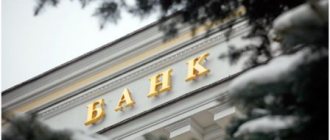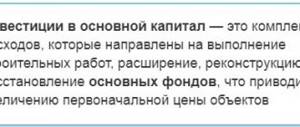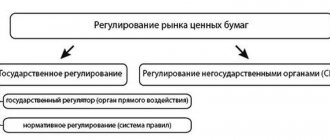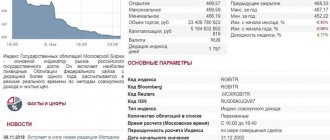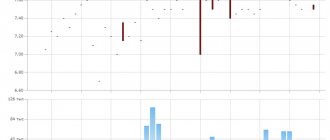Government bonds are positioned as a highly reliable alternative to bank deposits. Despite the real risks, investments in Russian debt securities are profitable, safe and relatively stable.
This is also the best tool that will help you diversify your portfolio or receive a constant, predictable income.
Characteristics and features of securities
The parameters of government bonds are similar to other debt securities:
- par value - price at issue;
- market value - the selling price on the market, resulting from the interaction of supply and demand;
- coupon rate - interest on the use of the holder's money;
- redemption date—the day the coupons are redeemed;
- maturity is the length of time the bond is held by the investor;
- redemption amount - funds paid by the issuer upon redemption.
The features of OFZ include:
- Low investment risk.
- Preferential taxation, which increases the attractiveness of this instrument and compensates for the low profitability.
- Low profitability compared to corporate ones.
Other classification methods
In addition to the classifications mentioned above, government securities can be divided according to the following criteria:
- Indexation of payments . There are non-indexed securities, the payment of which is agreed upon once and does not change until the moment of payment, as well as indexed ones, whose payment amount increases, for example, by the amount of inflation.
- Security . Government bonds may be paid for by the issuer's property or may not have any collateral.
- Convertibility . If it is impossible to transfer the OFZ, it can be exchanged for other securities of a specific issuer. Otherwise, exchange is possible only for cash.
Pros and cons of government bonds
The advantages of investing in government bonds include:
- low financial risk;
- state guarantees of refund;
- a large selection of issued debt securities;
- their yield is less dependent on the term than bank deposits;
- availability;
- right of inheritance;
- possibility of early return of your money.
The disadvantage is the relatively low level of profitability. In this regard, corporate coupons are more profitable.
Types in the Russian Federation
In our country, government debt securities are called federal loan bonds. They are issued by the Russian Federation through the Central Bank and the Ministry of Finance.
Facts about OFZ
- Profitability from government bonds is at the level of the Central Bank rate.
- The income received by the investor is also affected by the maturity period - the longer it is, the higher the profit.
- OFZs are issued for short, medium and long terms, with the maximum term being 25 years.
- According to the method of redemption, OFZs are divided into ordinary (repurchased at the end of the term) and depreciation (funds are returned in installments).
- Income received from any bonds is taxed at 13%.
- Government debt securities are often called “risk-free bonds.”
OFZ N
These are securities with a circulation period of 3 years, placed by the Russian Ministry of Finance exclusively for individuals. Their cost is low, but their reliability is maximum. They are purchased from Sberbank and VTB 24.
OVVZ
These are foreign currency loan bonds - government debt securities traded on foreign stock markets. The denomination of these bonds is set in American dollars.
Eurobonds
These are foreign currency securities placed by the Ministry of Finance of the Russian Federation. Their reliability is higher than that of OFZs, since these are international debt obligations.
Different terms of redemption
In addition to the traditional method of repayment, there are possibilities for unilateral termination of the debt obligation:
- callable bonds - with the right of the issuer to redeem coupons early;
- convertible - provide for the holder’s obligation to exchange bonds for shares of the same issuer at the end of the term;
- with the right of early disposal - provide the investor with the opportunity to return the securities at any time.
Coupon rate
The coupon, or guaranteed interest rate, is the amount of compensation for the use of the investor’s money that he will receive from the state. There are several types of them:
- fixed - unchanged for the entire circulation period;
- floating - depends on certain conditions that may change;
- inverse floating - changes inversely in proportion to a certain value;
- zero - with no interest charges.
What it is?
A government bond is a security that confirms the fact that the government of a certain state (hereinafter referred to as the issuer of the bond) owes the owner of the bond a certain amount of money.
In the Russian Federation, the Ministry of Finance of the Russian Federation is in charge of issuing government bonds; they are called OFZ - Federal Loan Bonds. In the USA, for example, government bonds are issued by the US Treasury, and the bonds are called “treasures”. Government bonds are issued by the Ministries of Finance or Treasury of different countries, thereby providing a guarantee from the state.
Bonds can be not only government bonds, there are many varieties according to different parameters,
Risks
Risks accompany any investment. And although government bonds are recognized as a risk-free investment instrument, situations are still possible when their holder incurs losses.
Liquidity in the market
Liquidity is the speed at which an asset is sold. Taking into account the fact that bonds are not always in high demand, they can be sold quickly only due to a loss in price.
Interest rate
When interest rates rise, bond prices fall. As a result, if debt securities are returned early, their face value may be lower than when purchased, and the investor will lose part of his money.
Currency
Due to fluctuations in quotes, the value of securities issued in foreign currencies may also change. Accordingly, when exchange rates change, they are likely to be sold at a lower price.
Loans
Government loans can be external, internal and foreign currency. For an internal loan, the issuer receives funds from citizens and enterprises, as well as from other countries and international associations.
Foreign exchange domestic
This type of loan is aimed at attracting foreign currency funds. There are bonds with a par value in foreign currency (US dollars) and those that have been indexed. They are issued for 1 or 3 years.
External
An external government loan is a form of government receiving funds from external creditors. It is provided, as a rule, for 1-2 years by foreign companies and banks. For a period of more than 5 years, loans are issued by insurance organizations, banking houses and global investors.
Legal regulation
Legal aspects of the issue and circulation of OFZ are established by Federal laws:
- “On the securities market” dated April 11, 1996
- “On the peculiarities of the issue and circulation of state and municipal securities” dated July 17, 1998.
Frequency and size of government loan bond issues in the RSFSR and the USSR by year
| Year | Loan name | Type | Duration, years | Total amount in rubles |
| 1922 | First domestic short-term state grain loan | interest-free, win-win | 8 months | 10 million poods of rye |
| 1922 | State 6% winning loan | 6 percent winning | 10 | 100 million |
| 1923 | Second domestic short-term state grain loan | interest-free, win-win | 11 months | 100 million poods of rye |
| 1923 | State short-term sugar loan | interest-free, win-win | 11 months | 1 million poods of refined sugar |
| 1924 | 8% domestic gold loan | winning | 6 | 100 million |
| 1924 | Second government winning loan | 6 percent winning | 5 | 100 million |
| 1924 | Peasant winning loan | 5 percent winning | 21 months | 50 million |
| 1925 | State short-term 5% internal loan | 5% | 1 | 10 million |
| 1925 | State internal loan for economic recovery | percentage | 4,5 | 300 million |
| 1925 | Second peasant winning loan | 1% winning | 2 | 100 million |
| 1926 | Second state 8% internal loan | 8% | 5 | 100 million |
| 1926 | State domestic winning loan | winning | 5 | 30 million |
| 1927 | State domestic 10% winning loan | 10% winning | 8 | 100 million |
| 1927 | Third state 8% internal loan | 8% | 10 | 200 million |
| 1927 | Third peasant winning loan | 1% winning | 3 | 25 million |
| 1927 | State internal 12% loan | 12% | 10 | 200 million |
| 1927 | State internal 6% winning loan for the industrialization of the national economy of the USSR | 6 percent winning | 10 | 200 million |
| 1928 | State internal winning loan for strengthening peasant farming | 6 percent winning | 3 | 100 million |
| 1928 | The second state internal winning loan for the industrialization of the national economy of the USSR | two options: winning and 6 percent winning | 10 | 50 million |
| 1928 | State internal 11% loan | 11% | 10 | 300 million |
| 1928 | Fourth state 8% internal loan | 8% | 15 | 400 million |
| 1929 | The third state internal winning loan for the industrialization of the national economy of the USSR | two options: winning and 6 percent winning | 10 | 750 million |
| 1929 | State internal loan | winning | 5 | 125 million |
| 1930 | State domestic 9% winning loan | winning percentage | 10 | 50 million |
| 1930 | State internal winning loan “Five-year plan in four years” | two options: winning and 6 percent winning | 10 | 1.2 billion |
| 1931 | State internal loan “Five-year plan in four years” | 2 options: winning and 10% | 10 | 1.6 billion |
| 1932 | State domestic winning loan | winning | 10 | 100 million |
| 1932 | State internal loan of the fourth final year of the five-year plan | 2 options: winning and 10% | 10 | 3.2 billion |
| 1933 | State internal loan of the second five-year plan | three options: winning, 7 percent and 10 percent | 10 | 3 billion |
| 1934 | State internal loan of the second five-year plan | 2 options: winning and 10% | 10 | 3.5 billion |
| 1935 | State domestic winning loan | winning | 10 | 300 million |
| 1935 | State internal loan of the second five-year plan | 2 options: winning and 8% | 10 | 3.5 billion |
| 1936 | State internal loan of the second five-year plan | 2 options: winning and 4% | 20 | 4 billion |
| 1937 | State internal loan for strengthening the defense of the USSR | 2 options: winning and 4% | 20 | 4 billion |
| 1938 | State domestic winning loan | winning | 20 | 600 million |
| 1938 | State internal loan of the third five-year plan | 2 options: winning and 4% | 20 | 5.9 billion |
| 1939 | State internal loan of the third five-year plan | 2 options: winning and 4% | 20 | 6 billion |
| 1940 | State internal loan of the third five-year plan | 2 options: winning and 4% | 20 | 8 billion |
| 1941 | State internal loan of the third five-year plan | 2 options: winning and 4% | 20 | 9.5 billion |
| 1942 | State war loan | 2 options: winning and 2% | 20 | 10 billion |
| 1943 | Second State War Loan | 2 options: winning and 2% | 20 | 12 billion |
| 1944 | Third State War Loan | 2 options: winning and 2% | 20 | 25 billion |
| 1945 | Fourth State War Loan | 2 options: winning and 2% | 20 | 25 billion |
| 1946 | State loan for the restoration and development of the national economy of the USSR | winning | 20 | 20 billion |
| 1947 | State loan for the restoration and development of the national economy of the USSR | winning | 20 | 20 billion rubles |
| 1947 | State 3% domestic winning loan | two options: winning and 3 percent | 20 | 20 billion |
| 1948 | State loan for the restoration and development of the national economy of the USSR | winning | 20 | 20 billion |
| 1947 | State 2% loan | 2 options: winning and 2% | 20 | 20 billion |
| 1949 | State loan for the restoration and development of the national economy of the USSR | winning | 20 | 20 billion |
| 1950 | State loan for the restoration and development of the national economy of the USSR | winning | 20 | 20 billion |
| 1951 | State loan for the development of the national economy of the USSR | winning | 20 | 30 billion |
| 1952 | State loan for the development of the national economy of the USSR | winning | 20 | 30 billion |
| 1953 | State loan for the development of the national economy of the USSR | winning | 20 | 30 billion |
| 1954 | State loan for the development of the national economy of the USSR | winning | 20 | 30 billion |
| 1955 | State loan for the development of the national economy of the USSR | winning | 20 | 30 billion |
| 1956 | State loan for the development of the national economy of the USSR | winning | 20 | 30 billion |
| 1957 | State loan for the development of the national economy of the USSR | winning | 20 | 30 billion |
| 1966 | Government 3% Domestic Win Loan | 3% winning | 20 | |
| 1982 | State domestic winning loan | winning | 20 |
Interesting: Investing in bonds for beginners: market overview, risk assessment, strategy from expert Yuri Gugnin, Ph.D. on mathematical models in economics.
Government bond yield
The level of profit on government bonds is set at the level of the rate of the Central Bank of the Russian Federation. It is higher than for bank deposits, but lower than for corporate bonds.
The profit from such securities is determined by their market price at purchase, the size of the coupon and the term. The longer the coupon is held by the holder, the more income it brings.
The profit on foreign currency bonds is determined by a number of factors, but when sold, their cost can be several times higher than the nominal value.
It should be remembered that in case of early sale of government bonds, a commission fee will be withheld from the holder. Its maximum size is 3%. Accordingly, the proceeds from the sale will be less than planned.
Buying and selling
The turnover of government bonds occurs on the stock market.
They are purchased in three ways:
- Through a broker.
- By IIS. This method gives the investor the right to receive a tax deduction of 13%.
- By contacting Sberbank or VTB 24.
OFZ-n are allowed to be sold only at the financial institution where they were purchased. It is prohibited to transfer, give, use as collateral or a contribution to capital. But you can bequeath and transfer government bonds by inheritance.
Cost of federal loan bonds
The average unit price is about 1000 rubles. The minimum number that can be purchased is 30 pieces, and the maximum per person is 15 thousand pieces.
Bonds with constant coupon income
As of April 1, 2019, the cost of OFZ with constant coupon income is 1,000 rubles. Profitability ranges from 6.4 to 8.15% based on issue.
Variable coupon bonds
Their price today is set at 1000 rubles per unit. Their yield varies from 7.3 to 8.3%.
Bonds with indexed par value
The price of such bonds is set taking into account the consumer price index for goods and services. As of April 4, 2021, their denomination is set within the range of 1171.07 - 1198.19 rubles per unit. The accumulated coupon income, taking into account indexation, ranges from 0.72 to 8.29%.
Restoration of the national economy
From 1946 to 1950, signature winning loans for the restoration and development of the national economy began to be issued. Only 35% of the bonds were subject to winnings, and the whole bond was considered to have a face value of 100 rubles, smaller ones - in parts, and larger ones - in several numbers.
1948 2% Loan Bond
During the monetary reform of 1947, the deposits of the population were also recalculated. All bonds of the winning loan of 1938 were exchanged at a rate of 5:1 for new three-percent bonds of the 1947 model, and 8% bonds of 1927-1928 and bonds of 1936-1945 (except for the winning ones of 1938) at a rate of 3:1 for a 2% loan of 1948. Both were designed for 20 years. For the second, various obligations and certificates for receiving social benefits were exchanged. Since 1951, winning loans for the development of the national economy have been issued in denominations from 10 to 500 rubles, designed for 20 years. It was these issues that became the most widespread, many of them were never redeemed. In 1957, there were 300 billion rubles in deposits (about 1,500 rubles per resident of the country). In order not to burden the state with new internal debts, from now on the issuance of loans ceases and payments of winnings and interest are stopped for 20 years.
1952 bond in the amount of 500 rubles
